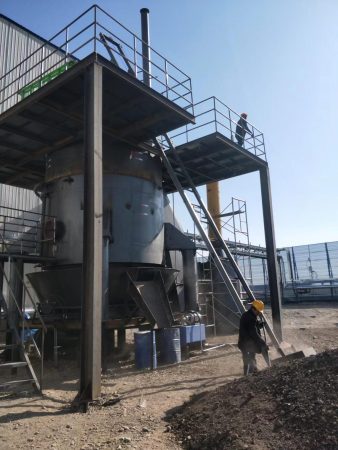The structural characteristics and working principles of dust removal and desulfurization towers can
be divided into packed towers and spray towers according to different structures. In the packed tower,
in order to facilitate full contact between the absorption slurry and the flue gas, the general
wet desulfurization absorption tower is divided into two types: co-current tower and counter-flow
tower according to the flow direction of the absorption slurry and flue gas. Several layers of
cyclone plates are arranged in the dust removal and desulfurization tower (depending on
the specific situation). The cyclone plate tower has good gas-liquid contact conditions.
The alkali liquid sprayed from the top of the tower is atomized on the cyclone plate,
and the carbon dioxide in the flue gas can be fully absorbed and react with the sprayed alkali liquid.
After desulfurization and washing, the clean flue gas is dehydrated by the demister and then enters the heat exchanger.
The heated flue gas is discharged into the atmosphere through the chimney by the induced draft fan.
1. Structure of dust removal and desulfurization tower:
The carbon dioxide absorption system mainly consists of the main dust removal and desulfurization tower,
connecting flue, mass transfer layer, spray layer, combined mist eliminator, embedded parts, external steel structure and flushing system.
2. Working principle of dust removal and desulfurization tower:
The flue gas after dust removal enters the tower body from the upper part of the slurry pool through the
entrance area of the dust removal and desulfurization tower. In the dust removal and desulfurization tower,
the hot flue gas contacts the slurry (circulating jet) in countercurrent from top to bottom, causing
a chemical absorption reaction and condensation. The added limestone slurry is transported to the dust
removal and desulfurization tower by the limestone slurry pump, and is mixed with the slurry in the dust
removal and desulfurization tower. The mixed slurry is transported upward by the circulation pump and
sprayed out from the multi-layer nozzle. The slurry absorbs sulfur oxides and other acids from the flue gases.
In the liquid phase, sulfur oxides react with calcium carbonate to form calcium sulfite. The dust removal
and desulfurization tower can be divided into two parts from top to bottom: the absorption area and the
oxidation crystallization area. The upper absorption zone has a higher pH value, which is conducive to
the absorption of acidic substances such as carbon dioxide; the lower oxidation zone operates at a low pH value,
which is conducive to the dissolution of limestone and the generation of by-products. Concentrate and
dehydrate the gypsum slurry discharged from the dust removal and desulfurization tower to make the water
content less than 10%, and produce gypsum products. The desulfurized flue gas passes through the
demister in order to remove mist droplets, and then is heated by a heat exchanger or
heater before being discharged into the atmosphere through the chimney.
3. High desulfurization and dust removal efficiency;
Through the mass transfer layer of the flue gas, the contact surface between the flue gas and the aqueous
solution is increased, the full dissolution and neutralization of the flue gas and the spray water are accelerated,
and the dust removal efficiency of the dust collector is improved. The dust removal efficiency is above 98%,
and the desulfurization efficiency is above 89%. This is rare in domestic wet dust removal.
After the desulfurization and desulfurization tower equipment undergoes desulfurization and dust removal,
the flue gas mist passes through the high-speed cyclone separator, and the flue gas mist is separated
by the high-speed cyclone separator. However, because the water content of the flue gas is relatively low,
no water vapor can be seen during exhaust. , and will not cause corrosion to the induced draft fan and flue.


